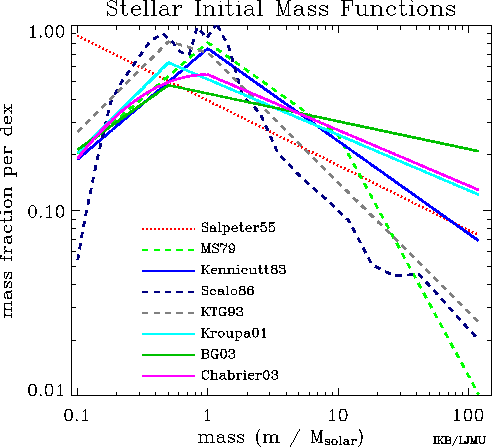new week, new topic - actually we'll be doing a lot of extragalactic globulars and the mass function of the clusters, but we start with Guido summarizing what we know about the stellar mass function within the clusters - including mass segregation and differential mass loss.
Wheee.

Sometime things are all topsy-turvy
as you know, Bob, stars come in a range of masses - going from about 0.1 solar masses (stars less massive than that are demoted to being non-stars, since they do not support thermonuclear fusion of hydrogen (1) in their cores on a sustained basis), up to somewhere around 100 solar masses, the upper mass limit possibly depending on composition and is effectively set by the propensity of more massive objects to spontaneously disassemble through radiation pressure.
As a first approximation, across that interval the distribution of stars is a scale-free power law, well approximated by a power law index x=-1.35, as famously noted by Ed Salpeter.
Just to confuse physicists, we usually quote MdN/dM and the actual index is (-1 -x), or somewhat steeper than -2 - ie mass diverges to lower masses.
As a second approximation, the mass function has some break points, with a characteristic mass maybe a little bit higher than a solar mass (above which the mass function steepens to maybe -1.7 +/-) and it also flattens, maybe down around 0.3 solar masses or so, with a sharp turnover near the 0.1 solar mass point (or maybe it curves gently to turnover, it is hard to tell).
To further complicate things, the Present Day Mass Function is the folded evolved mass function, with stellar remnant coming back in to the mass function at the point indicated by the (somewhat uncertain) initial-final mass relation ship. And if there are multiple or continuous episodes of star formation, the overlapping IMFs are convolved back to the combined PDMF.
But I digress.
As a zeroth approximation, the IMF is universal - same in all places and times;
as a first approximation, it is not, but in the mean the different IMFs convolve to approximate a universal MF; as a second approximation IMFs are very different, in particular the "first stars", the metal free stars formed early in the universe had a very top heavy mass function, with characteristic mass > 100 solar masses, we think, in theory.
There may have been intermediate mass functions early on in the universe, and may continue to be in exotic environments, like the high pressure environment near the centers of galaxies; and there are conjectures that very bottom heavy mass functions may occur in "cooling flows".
Oh, and we don't measure mass, we measure brightness, which we translate to luminosity, after colour corrections, which we then translate to mass...
Since it is easy to see lots of (near) co-eval stars in globulars, they are a good place to count stars and measure the IMF.
Like see if the clusters all have the same global IMF.
But, first clusters mass segregate, so the local PDMF is biased depending on where you look in the cluster, but theoretically if you look near the half-mass radius the population there should be more or less unbiased; and, you ought to have differential mass loss, with preferential loss of low mass stars from the outskirts, if segregation is effective and tidal evaporation proceeds as predicted in models.
Or not.
So now we have data.
Good data.
And we know nothing.
So... are mass functions (in globulars) really log-normal with characteristic mass of 0.3 solar masses?
Is this actually consistent with the field?
Are we, again, finding that multiply truncated power laws tend to mimic log-normal distributions and we're doing poor parametric fits?
Problem is, the power law index is observed to anti-correlate with concentration
(cf de Marchi et al 2008)
So... one way out is that we're seeing highly differential mass loss with clusters formed initially mass segregated, and the dominant issue being whether the cluster formed with most of the mass deep inside its tidal radius, or if it formed overflowing its tidal radius,
ie it would depend on the cluster's galactic orbit... ratio of perigalacton to apogalacton is a strong factor.
Hmmm. Maybe [ed].
Of course now that we have multiple stellar populations in clusters we can ask whether in addition to having different composition, including conceivable different primordial helium content - do they have different IMFs?
That would make life interesting, eh?
Apparently the indications are that the different populations, if they are there, do have the same IMFs.
Hm - fragmentation is not sensitive to He content? No relevant He lines that provide cooling at low temperatures, so we intuit that IMF and binarity ought not to depend on He content.
So they should depend on metals, at least for regimes where you haven't saturated the cooling function at low T high ρ
but I digress
New result from Guido - best fit characteristic mass for globulars goes like the square root of the age of the cluster in dynamical time: mc = 0.1 + √tdyn/2
where tdyn = t/tdiss and tdiss ~ M0.6
or ~ (N/log(N))0.8 R/v
Hmm. Nice plot.
caveat - the observers, of course, are really talking the LMF on the main sequence, which is not the same as the theorists PDMF which includes the stellar remnants

these mostly agree, on a log scale
(shamelessly swiped from Ivan Baldry's website)
